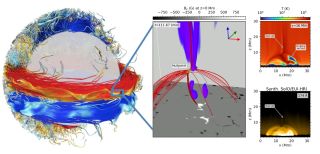Bibcode
Luna, Manuel; Moreno-Insertis, Fernando
Bibliographical reference
The Astrophysical Journal
Advertised on:
5
2021
Journal
Citations
17
Refereed citations
17
Description
Observational evidence shows that coronal jets can hit prominences and set them in motion. The impact leads to large-amplitude oscillations (LAOs) in the prominence. In this paper, we attempt to understand this process via 2.5D MHD numerical experiments. In our model, the jets are generated in a sheared magnetic arcade above a parasitic bipolar region located in one of the footpoints of the filament channel (FC) supporting the prominence. The shear is imposed at velocities not far above the observed photospheric values; this leads to a multiple reconnection process, as obtained in previous jet models. Both a fast Alfvénic perturbation and a slower supersonic front preceding a plasma jet are issued from the reconnection site; in the later phase, a more violent (eruptive) jet is produced. The perturbation and jets run along the FC; they are partially reflected at the prominence, and partially transmitted through it. This results in a pattern of counter-streaming flows along the FC, and oscillations in the prominence. The oscillations are LAOs (i.e., with amplitudes above 10 km s-1) in some areas of the prominence, both in the longitudinal and transverse directions. In some field lines, the impact is so strong that the prominence mass is brought out of the dip and down to the chromosphere along the FC. Two cases are studied, with respect to arcades at different heights above the parasitic bipolar region, leading to different heights for the region of the prominence perturbed by the jets. The obtained oscillation amplitudes and periods are in general agreement with the observations.
Related projects

The Whole Sun Project: Untangling the complex physical mechanisms behind our eruptive star and its twins
The Sun is a magnetically active star with violent eruptions that can hit Earth´s magnetosphere and cause important perturbations in our technology-dependent society. The objective of the Whole Sun project is to tackle in a coherent way for the first time key questions in Solar Physics that involve as a whole the solar interior and the atmosphere
Fernando
Moreno Insertis

Numerical Simulation of Astrophysical Processes
Numerical simulation through complex computer codes has been a fundamental tool in physics and technology research for decades. The rapid growth of computing capabilities, coupled with significant advances in numerical mathematics, has made this branch of research accessible to medium-sized research centers, bridging the gap between theoretical and
Daniel Elías
Nóbrega Siverio